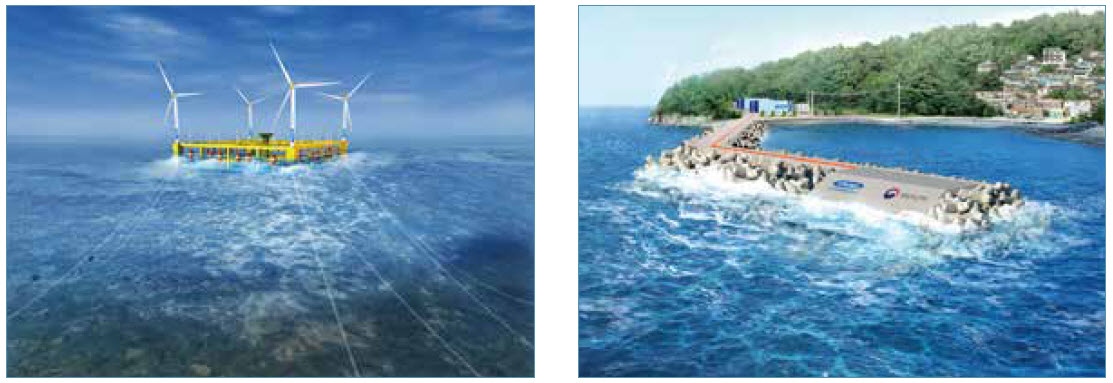REPUBLIC OF KOREA
10 MW Class Wave-Offshore Wind Hybrid Power Generation System
The main objective of this project was to develop the design technology for the 10 MW wave offshore wind hybrid power generation system and to design the 10 MW standard model powered by the deep ocean energy resource. The project, with the duration of approximately 3 years, from June 2013 to May 2016, was supported by the Korean Government, through the Ministry of Oceans and Fisheries, with USD 11 million for the total amount of funding. The project team was organised and led by KRISO and 10 universities (8 Domestic and 2 International), 5 research institutes (4 Domestic and 1 International), and 10 industrial companies (8 Domestic and 2 International). The major research contents for the project were as follows:
- Development of design technology for a floating wave-offshore wind hybrid power generation system;
- Development of structural safety analysis and high strength material application technology for a large floating wave-offshore wind hybrid power structure;
- Development of integrated control and grid connection technology for wave-offshore wind hybrid power generation system;
- Development of design standardization and practical application technology for a wave-offshore wind hybrid power generation system;
- As a result, the project has succeeded to develop the design of a floating wave-offshore wind hybrid power generation system, as well as the performance analysing programme with the design manuals for the floating wave-offshore wind power generation system.
Wave Energy Converter with Energy Storage System Applicable to Breakwaters in Remote Island
The present research project is aimed to establish the commercializing foundation for the ocean energy by developing the integrated energy storage system and wave energy converters, applicable to the breakwater in remote harbours and ports. The project, with the duration of approximately 4 years, from May 2016 to December 2020, is supported by the Korean Government, through the Ministry of Oceans and Fisheries. The major research contents for the project are as follows:
- Prioritization of potential sites for the wave power generation, and detail survey and analysis on their environmental conditions;
- Development of a standard model of small capacity wave energy converters (WECs) applicable to the breakwater;
- Development of interface technologies of an integrated system of wave power converters and energy storage system (ESS), useful for remote islands with independent micro grid network;
- Sea test of a pilot plant of the integrated system of WECs applied to the breakwater and ESS embedded to the independent micro grid system.
In 2016, the basic survey for potential sites and determination of the pilot plant location for WECs was carried out, as well as the conceptual design of the small WEC system, applicable to the breakwater, and the micro grid system with the independent source of WECs.

10 MW wave-offshore wind hybrid system (left) & WEC applicable to breakwaters in remote island (right)
Arrayed Buoy Wave Energy Converter Adaptive to Wave Climate
The research and development project for the 1 MW arrayed-buoy wave energy converter, started in December 2016 with four years of project duration, is aimed at developing the basic design of an arrayed-buoy, the floating platform, and the swivel power cable system. The system will consist of the floating platform, the weather vanning mooring system, the Salter’s duck type wave energy converters, and the hydraulic power take-off system. Furthermore, the system will be equipped with the motion suppression mechanism to maximise the generated power from the array-buoy. The project is expected to be ended by 2020 after the sea trial near the Jeju Island.



